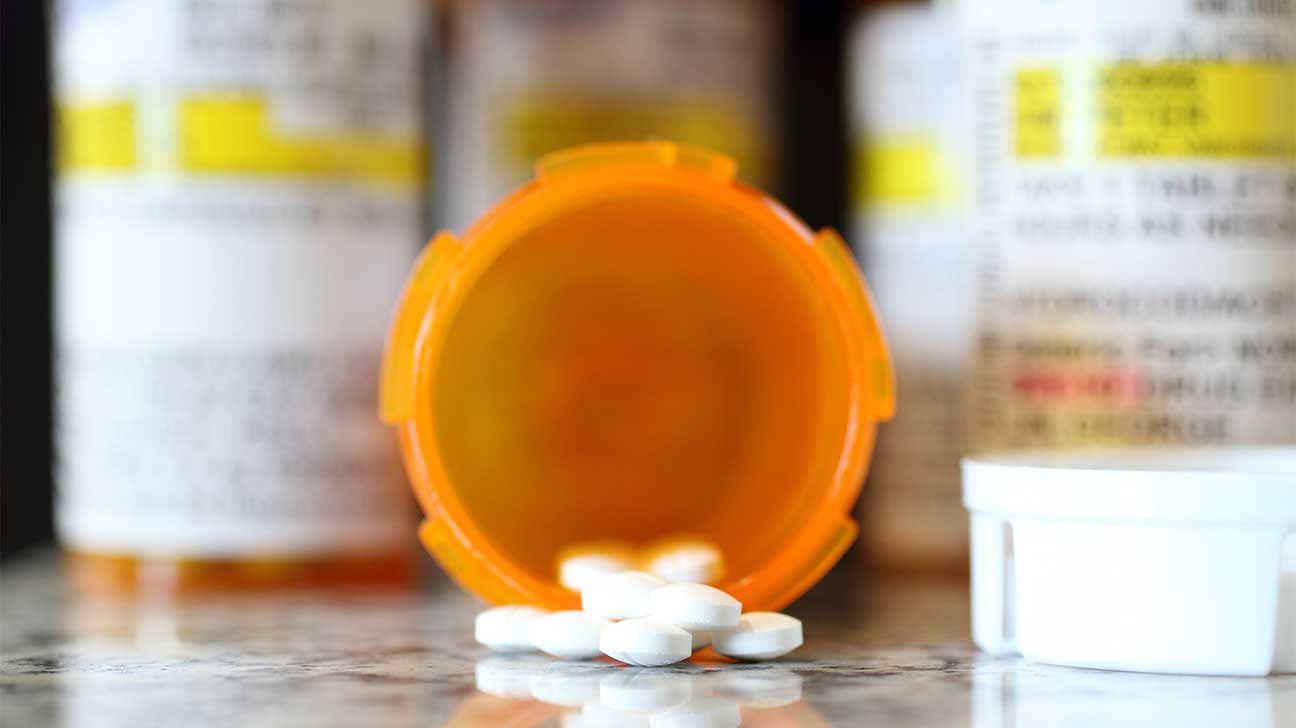Roxicodone Vs. Oxycodone | Differences & Similarities
Roxicodone is a brand name for oxycodone, a semi-synthetic opioid painkiller. This specific brand is no longer on the market, but other similar options are available in the United States.

Oxycodone is an opioid analgesic drug prescribed for moderate to severe pain relief. It’s typically prescribed only in cases of chronic pain management that haven’t responded to milder painkillers. Roxicodone is a brand name for oxycodone.
How Are Roxicodone & Oxycodone Different?
The only active ingredient in Roxicodone is oxycodone hydrochloride. Roxicodone came in blue immediate-release tablets containing 15 mg or 30 mg of oxycodone, but the branded drug Roxicodone is no longer on the market.
OxyContin is another brand name for oxycodone hydrochloride still available in the United States. It’s an extended-release tablet available in many colors, including red, brown, pink, gray, white, and green.
Generic oxycodone is made in immediate-release and extended-release formulations. You can get oxycodone as a liquid, concentrated solution, tablet, or capsule.
Sometimes oxycodone comes in combination with over-the-counter pain medications, such as ibuprofen (Motrin), acetaminophen (Tylenol), or aspirin.
Oxycodone combination drugs include:
- Combunox (oxycodone and ibuprofen)
- Oxycet (oxycodone and acetaminophen)
- Percocet (oxycodone and acetaminophen)
- Roxicet (oxycodone and acetaminophen)
- Percodan (oxycodone and aspirin)
Oxycodone combination drugs work the same as straight oxycodone but have the added benefit of a different pain reliever that may make it more effective.
Roxicodone & Oxycodone Effects
Roxicodone and oxycodone are central nervous system depressants. They target opioid receptors to decrease brain activity and pain signals. They relax your body and mind and can make you feel euphoric.
The euphoria and intense calm produced by oxycodone and Roxicodone make them attractive for substance abuse. However, misusing oxycodone increases the risk of complications and side effects.
Common side effects of Roxicodone (oxycodone) may be:
- drowsiness
- stomach pain
- constipation
- headache
- flushing
- dry mouth
- mood changes
Serious side effects of oxycodone include:
- chest pain
- changes in heartbeat
- swelling in the face or extremities
- difficulty breathing or swallowing
- hives, itching, or rash
- extreme drowsiness, sedation
- irregular menstruation
- decreased sexual desire and ability
- nausea, vomiting, loss of appetite
- weakness, dizziness, lightheadedness
If you have severe side effects, tell your doctor or seek medical attention immediately.
Roxicodone (Oxycodone) Overdose
Roxicodone (oxycodone) slows down your breathing and heart rate. If you take too much, you could stop breathing or have difficulty taking full breaths. The lack of oxygen to your brain and body can cause loss of consciousness, coma, and permanent brain damage.
Opioid overdose may be fatal. Taking high doses of oxycodone or using it too often can cause an overdose. Mixing it with other opioid medications, such as hydrocodone (Vicodin, Norco), also raises overdose risk.
Naloxone (Narcan) is a widely available opioid antagonist that temporarily reverses overdose symptoms. If someone is with you when you overdose, they can give you naloxone to keep you alive while you wait for medical assistance.
Most states, including Ohio, have Good Samaritan laws that protect you from criminal consequences if you call 911 for someone who overdosed.
Oxycodone In Ohio
The US Drug Enforcement Administration (DEA) classifies oxycodone as a Schedule II controlled substance. It’s one of the most widely prescribed and widely abused opioids on the market.
Oxycodone (Roxicodone) has a high potential to be abused, which usually leads to opioid addiction and physical dependence.
The State of Ohio Board of Pharmacy places strict limits on prescribing opioid drugs like oxycodone. In addition to daily dosage limitations, opioids typically cannot be prescribed for more than seven days to an adult in Ohio.
Close monitoring of opioid prescriptions seems to be helping. Over the last few years, Ohio overdose deaths including synthetic opioids like oxycodone have steadily decreased (from 812 in 2017 to 415 in 2020). Eight percent of 2020 drug overdoses involved synthetic opioids.
Roxicodone Addiction Treatment
If you or a loved one abuses Roxicodone (oxycodone) or struggles with opioid addiction, now is the time to get help.
Addiction is a devastating disease that can consume you. Treatment facilities like Ohio Recovery Center are available to stop the progression of addiction and give you back your life and health.
Our customized rehab programs at Ohio Recovery Center are made up of evidence-based treatment options and experiential therapies. You may participate in cognitive behavioral therapy, fitness programs, yoga, meditation, and art therapy.
We also offer medical detox and medication-assisted treatment (MAT) to ease the process of weaning off opioids into a substance-free life. Medication combined with therapy helps many people stay in treatment by reducing opioid cravings and withdrawal symptoms.
Reach out to one of our treatment specialists today to learn more and start your healing journey now.
Roxicodone Vs. Oxycodone Frequently Asked Questions
Roxicodone is an immediate release brand of oxycodone that is no longer available in the United States. However, people may have questions regarding the current legality of the drug as well as illicit use.
What Are Other Names For Roxicodone?
When Roxicodone is sold on the street, it goes by a number of names.
Slang terms for Roxicodone include “roxies” and “roxys.” Street names for generic oxycodone may include “OC,” “O,” “oxy,” and “hillbilly heroin.”
Is Roxicodone More Dangerous Than Oxycodone?
Roxicodone is an immediate release form of oxycodone, which means they are the same drug with different release mechanisms.
Research shows that immediate release formulations are not typically more dangerous than drugs with a slower release.
In fact, extended release drugs have a marginally higher risk of nonfatal overdose. However, people who use opioids should always act with caution.
- Food and Drug Administration https://www.accessdata.fda.gov/drugsatfda_docs/label/2009/021011s002lbl.pdf
- National Library of Medicine: MedlinePlus https://medlineplus.gov/druginfo/meds/a682132.html
- National Library of Medicine: DailyMed https://dailymed.nlm.nih.gov/dailymed/drugInfo.cfm?setid=bfdfe235-d717-4855-a3c8-a13d26dadede
- National Library of Medicine: DailyMed https://dailymed.nlm.nih.gov/dailymed/drugInfo.cfm?setid=d48c22ff-bbb4-4a93-a35b-6eebff7b8e53
- Ohio Department of Health https://odh.ohio.gov/wps/wcm/connect/gov/6a94aabe-ea77-4c01-8fd8-2abdd83b4ff8/2020%2BUnintentional%2BDrug%2BOverdose%2BAnnual%2BReport.pdf?MOD=AJPERES&CONVERT_TO=url&CACHEID=ROOTWORKSPACE.Z18_K9I401S01H7F40QBNJU3SO1F56-6a94aabe-ea77-4c01-8fd8-2abdd83b4ff8-o2GcAjB#:~:text=Illicit%20fentanyl%20or%20fentanyl%20analogs,in%20combination%20with%20other%20drugs.&text=In%202020%2C%20Ohio%20deaths%20related,psychostimulants%2C%20which%20increased%2028%25.
- State of Ohio Board of Pharmacy https://www.pharmacy.ohio.gov/Documents/Pubs/Special/ControlledSubstances/For%20Prescribers%20-%20New%20Limits%20on%20Prescription%20Opioids%20for%20Acute%20Pain.pdf

